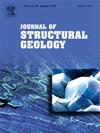达尔马提亚单元基底逆冲的上新世-第四纪活动——杜布罗夫尼克震源区一个潜在的孕震源
IF 2.9
2区 地球科学
Q2 GEOSCIENCES, MULTIDISCIPLINARY
引用次数: 0
摘要
这项研究的重点是在杜布罗夫尼克市周围的外迪纳里德斯东南部确定地震活跃的结构。更广泛的区域的特点是相对较高的地震活动率,间歇性地发生强烈事件,表明正在进行的构造活动。历史、仪器和古地震记录表明,在过去的3000年里,这个地区至少受到了12次强烈地震的影响。其中,最严重的是1667年的杜布罗夫尼克大地震(里氏6.9级),摧毁了该地区。为了识别杜布罗夫尼克近海地区的潜在孕震源和活动断层,对106条海上二维地震线和3口深探井进行了分析。通过将记录的地震活动性和陆上地质构造资料的震源分布与海上二维地震线和测井资料进行对比,绘制了已识别的海上断层图,构建了区域平衡地震构造剖面。研究结果表明,杜布罗夫尼克近海的主要孕震源与外迪纳里季达尔马提亚构造单元的北东倾前缘逆冲和断层展布有关。同构造沉积和褶皱的上第三纪-第四纪沉积记录了该断裂系统的持续扩展,沿走向可追溯40公里。基于运动学模型,估算出晚中新世至近代活跃锋面冲断及其扇形的平均滑移率为1.13 mm/yr,而平均缩短率为0.9 mm/yr。因此,这些发现暗示了重复的孕震事件,如1667年的一次,以适应该地区的缩短。本文章由计算机程序翻译,如有差异,请以英文原文为准。
Pliocene-Quaternary activity of the Dalmatian unit basal thrust – a potential seismogenic source in the Dubrovnik epicentral area (Croatia)
This study focused on the identification of seismically active structures in the southeastern part of the External Dinarides around the city of Dubrovnik. The wider region is characterized by a relatively high seismicity rate, with intermittent occurrences of strong events, indicating ongoing tectonic activity. Historical, instrumental, and paleoseismological records indicate that this area has been affected by at least a dozen strong earthquakes over the last 3000 years. Among these, the most significant was the Great Dubrovnik earthquake from 1667 (ML = 6.9), which devastated the region. To identify potential seismogenic sources and active faults in the Dubrovnik offshore area, 106 offshore 2D seismic lines and three deep exploration wells were analysed. Identified offshore faults were mapped, and a regional balanced seismotectonic cross-section was constructed by correlating the hypocentral distribution of recorded seismicity and onshore geological and structural data with offshore 2D seismic lines and well logs. Our results suggest that the main seismogenic source offshore of Dubrovnik is related to the NE-dipping frontal thrust and fault splays of the Dalmatian tectonic unit in the External Dinarides. The ongoing propagation of this fault system is documented by syn-tectonic deposition and folded Plio-Quaternary sediments that can be traced for 40 km along the strike. Based on kinematic modelling, the average slip rate estimated for the active frontal thrust and its splays is 1.13 mm/yr, while average shortening is 0.9 mm/yr from the Late Miocene to recent times. These findings are thus suggestive of repeated seismogenic events, such as the one in 1667, to accommodate shortening in the area.
求助全文
通过发布文献求助,成功后即可免费获取论文全文。
去求助
来源期刊

Journal of Structural Geology
地学-地球科学综合
CiteScore
6.00
自引率
19.40%
发文量
192
审稿时长
15.7 weeks
期刊介绍:
The Journal of Structural Geology publishes process-oriented investigations about structural geology using appropriate combinations of analog and digital field data, seismic reflection data, satellite-derived data, geometric analysis, kinematic analysis, laboratory experiments, computer visualizations, and analogue or numerical modelling on all scales. Contributions are encouraged to draw perspectives from rheology, rock mechanics, geophysics,metamorphism, sedimentology, petroleum geology, economic geology, geodynamics, planetary geology, tectonics and neotectonics to provide a more powerful understanding of deformation processes and systems. Given the visual nature of the discipline, supplementary materials that portray the data and analysis in 3-D or quasi 3-D manners, including the use of videos, and/or graphical abstracts can significantly strengthen the impact of contributions.
 求助内容:
求助内容: 应助结果提醒方式:
应助结果提醒方式:


